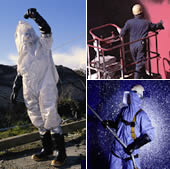NIOSH’s Protective Clothing and Ensembles Program is aimed at protecting the skin from various health hazards that may be encountered in the workplace or during a terrorist attack. The program has evolved over the years to incorporate a broad range of studies of how chemicals seep through barrier materials, leak through small holes, or change the barrier material to reduce its protection.
In addition to field surveys of CPC performance, studies continue to
examine ways to detect when chemicals have gotten inside chemical protective
clothing (CPC), and how to effectively remove chemicals from protective
clothing after it has been contaminated. Future efforts will incorporate
advanced protective clothing technologies into fully-integrated, intelligent
ensembles for fire fighters and emergency first responders.
Selections
Recommendations for Chemical
Protective Clothing
Provides assistance in identifying potentially appropriate types of chemical
barrier material for protection against skin contact with chemicals.
Recommendations for the Selection and Use of Respirators and Protective Clothing for Protection Against Biological Agents
DHHS (NIOSH) Publication Number 2009-132 (April 2009)
Protective clothing may be needed to prevent skin exposures and/or contamination
of other clothing during exposure to biological agents. The type of
protective clothing needed will depend upon the type of agent, concentration,
and route of exposure.
NIOSH Interim Guidance on Personal Protective Equipment and Clothing for Flood Response Workers
Provides information on hazards to flood cleanup workers, and
guidance for selecting clothing and protective equipment.
NIOSH Publications
Estimating the Permeation Resistance of Nonporous Barrier Polymers to Sulfur Mustard (HD) and Sarin (GB) Chemical Warfare Agents Using Liquid Simulants
DHHS (NIOSH) Publication No. 2008-141 (July 2008)
The purpose of this document is to report the results of the NIOSH Chemical Warfare Agent (CWA) Simulant Project.
A Guide for Evaluating the Performance
of Chemical Protective Clothing
DHHS (NIOSH) Publication No. 90-109 (June 1990)
This guide describes a method by which an industrial hygienist or equivalent
safety professional can select appropriate chemical protective clothing
(CPC) to protect a worker's skin from contacting chemicals.
Occupational Safety and Health
Guidance Manual for Hazardous Waste Site Activities
DHHS (NIOSH) Publication No. 85-115 (October 1985)
Guidance document for managers responsible for occupational safety and
health programs at inactive hazardous waste sites.
Other NIOSH Resources
Personal Protective Technology Program Projects
The activities of the Personal Protective Technology (PPT) Program are summarized in the form of quad charts. The quad charts provide a quick visual snapshot of the project by providing the 1) objective of the project, 2) key milestones for the project, 3) lists of partners and stakeholders, 4) outputs and outcomes. The quad charts for the PPT Program are separated into three categories to reflect the goals of the Cross-Sector. The PPT Program project distributions for 2009 and 2008 can be viewed by clicking on the year.
Permeation Calculator
DHHS (NIOSH) Publication No. 2007-143c (Version 2.4.1)
Permeation Calculator, a Microsoft Windows compatible program is a computer tool for automating the permeation testing data analysis.
NIOSH Pocket Guide to Chemical
Hazards
DHHS (NIOSH) Publication No. 2005-149 (September 2005)
Exposure limits, Respirator Recommendations, First Aid, more...
The Pocket Guide is a source of general industrial hygiene information on several
hundred chemicals/classes found in the work environment. Key data provided for
each chemical/substance includes name (including synonyms/trade names), structure/formula,
CAS/RTECS Numbers, DOT ID, conversion factors, exposure limits, IDLH, chemical
and physical properties, measurement methods, personal protection, respirator
recommendations, symptoms, and first aid.
Related NIOSH Topic Pages
- Chemical Safety
- Emergency Response Resources
- Occupational Latex Allergies
- Skin Exposures and Effects
Other Resources
PROJECT HEROES: Homeland Emergency Response Operational
and Equipment Systems
![]() PDF
only 780 KB (128 pages)
PDF
only 780 KB (128 pages)
A review of modern fire service hazards
and protection needs prepared by the International Association of
Fire Fighters under contract with NIOSH.
A Review of Gaps and Limitations in Test Methods
for First Responder Protective Clothing and Equipment
![]() PDF
only 752 KB (101 pages)
PDF
only 752 KB (101 pages)
This
report presents the results of a review aimed at identifying test
methods for protective clothing for first responders, as well as
identifying areas in which further research is required. Prepared
by Dr. Roger L. Barker under contract with NIOSH.
Page last reviewed: May 22, 2009
Content Source: National Institute for Occupational Safety and Health (NIOSH)
National Personal Protective Technology Laboratory

